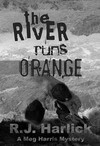
The River Runs Orange
R. J. Harlick
Rendez-Vous Crime
$15.95
paper
300pp
978-1-894917-62-9
At this point the storyline is taken over by the question of who should control the disposition of the De Montigny Lady, as the skeleton is called: the native peoples on whose land the bones were found, the federal or provincial governments, or some unscrupulous traffickers in ancient tribal artefacts. The story spins off into numerous subplots, all well researched, with some more interesting than others. The bones are repeatedly stolen and passed from one group to another. Bad things start to happen, including the stabbing death of one of the paleo-anthropologists. Deep divisions occur within Eric’s band and quarrels spring up everywhere. In the end, after another vivid and terrifying canoe trip down the De Montigny, this time through a forest fire, the killer is arrested and conflicts are resolved, though not entirely to the reader’s satisfaction. mRb






0 Comments